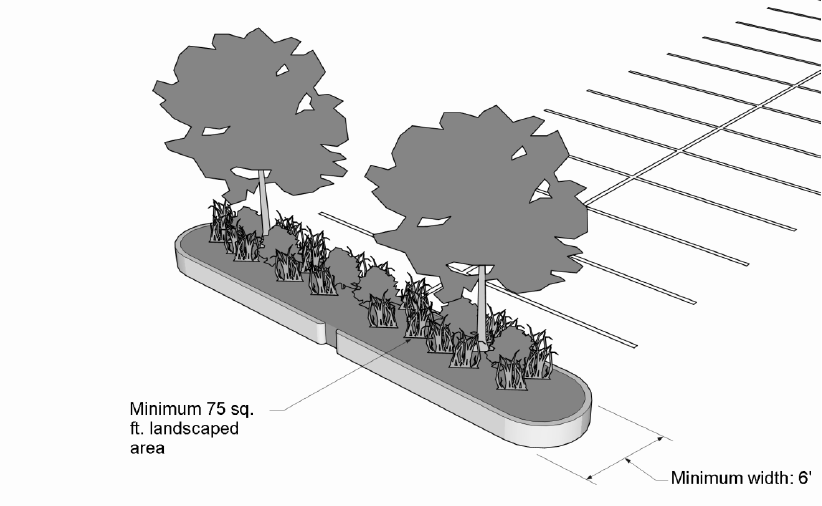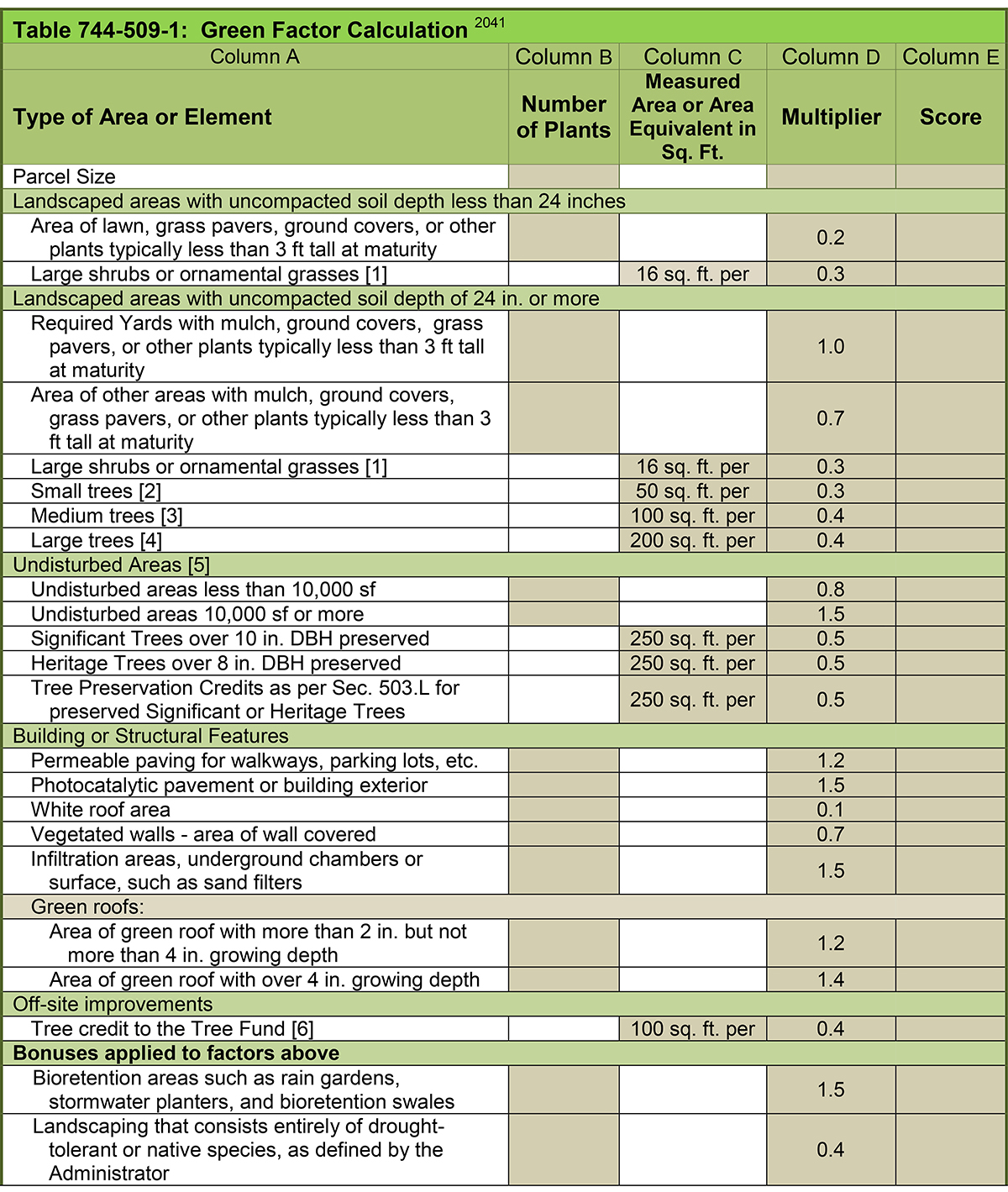Landscaping Ordinance
How it Works
Landscaping regulations establish minimum standards for the amount and types of landscaping, the location of landscaping, buffer and screening standards (to address visual impacts from development activities or site features), fence requirements, and installation and maintenance. Many codes also include standards for tree preservation, water efficiency and conservation, and low-impact development.
In addition to providing a more aesthetic environment, landscaping regulations can help reduce risk to natural hazards, including flood, drought, geologic hazards, wildfire, and extreme heat. Requiring a certain amount of landscaping reduces the amount of impervious coverage on a site, allowing water to percolate into the site instead of being conveyed across the site. Designating appropriate plant species for a dry climate can improve the water-efficiency of a site, which is especially important during periods of prolonged drought. Installing plants and ground cover helps stabilize steep and unstable slopes. Establishing standards for the type and location of landscaping can also reduce wildfire risk to structures.
Landscaping regulations are typically adopted as part of the zoning and development regulations either as a standalone chapter or article, or as a component of the larger development standards article or chapter. Formal adoption by the local governing body is required to enact or modify the landscaping standards.
Landscaping regulations typically include the following fundamental elements, which are further described in the model landscaping ordinance.
The following items should be considered when developing a landscape ordinance:
- Purpose and Intent. The purpose and intent statement is the jurisdiction’s opportunity to describe the reasoning behind, and benefits of, the landscaping ordinance, and its relationship to mitigating hazards.
- Applicability. The applicability section describes the types of development activities that are subject to the regulations, including thresholds for compliance for infill and redevelopment projects. This is important because one of the biggest challenges in planning for hazards is the ability to impact existing development.
- Site Landscaping. Site landscaping standards establish the essential landscaping rules for new development and redevelopment, such as how much landscaping is required, and where landscaping should be located. These standards are critical to mitigation efforts such as managing stormwater, preventing structure-to-structure ignitions during a wildfire, or reducing water use and creating resilience to drought events. Often these standards vary depending on the use type or zoning district (e.g., residential vs. commercial or industrial).
- Parking Lot Landscaping. Landscaping within parking areas is often separated from other site landscaping regulations because of the large amount of impervious surface involved. Even on sites with ample open space, it is still important to break up large areas of parking with plant material to help slow the flow of water across the site and to reduce the urban heat island effect. Another key consideration for many Colorado communities is establishing adequate areas for snow storage that are adjacent to paved areas. Such standards allow for infiltration of melting and runoff, and can ensure the protection of landscaped areas by requiring planting boxes, elevated planters, timbers, or other means.
- Landscaping Materials. The type of landscaping material used can be as important as the amount of landscaping called for. Plant species native to Colorado or the West, or otherwise drought-tolerant species, require less irrigated water, and can survive prolonged periods of drought. To address wildfire risk, local plant lists may differentiate appropriate species based on their flammability. In addition to specifying which plant species are allowed or recommended, communities may also want to identify species that are prohibited, for the reasons indicated above. Many communities also limit the amount of turf grass, or other high-water usage plants, by establishing maximum percentages.
- Tree Preservation. Protecting existing trees provides a way to reduce the urban heat island effect, reduce energy use, and allow water to infiltrate the ground instead of being conveyed away from the site. Communities vary in complexity of their tree-preservation standards. Some award credits for protecting existing trees, whereas more stringent standards require a minimum tree canopy to be maintained and identify specific species for tree replacement upon die off. Tree preservation standards can also be in direct conflict with wildfire risk reduction, since many communities require the removal or thinning of existing trees to maintain defensible space.
- Landscaping Plan Evaluation. Planners should consider hazard mitigation as part of a larger set of site development principles, and landscaping should be part of that evaluation to demonstrate how communities are protecting sensitive areas. The landscaping ordinance should establish a clear process for the review and approval of landscape plans associated with a site development application.
- Installation and Maintenance. Once a development is approved, and a building permit is issued, it is important to establish enforceable regulations for the installation of landscape materials. Landscaping can only be effective when it is properly maintained, so replacement standards for dead or dying vegetation are also often included. Irrigation systems are particularly important for water efficiency purposes, ensuring that minimal water resources are used, and that prolonged use of irrigation is not required for xeriscape landscaping areas.
When a development is proposed, the landscaping standards are typically evaluated as part of the overall development application. During the evaluation, the planner (or in some cases, a landscape architect or engineer) reviews the applicant’s landscape plan for compliance with the various provisions in the landscaping regulations. This evaluation can also be conducted as part of a building permit review process if a site plan or specific development application is not associated with the proposed project. A site inspection – which often includes landscaping installation as part of the inspection – is typically conducted on a site prior to issuing a certificate of occupancy. Some communities also require financial security be posted to assure that landscaping is installed in a timely manner (within a year), and that the landscaping survives a certain number of growing seasons.
Most communities regulate landscaping to some degree through their land use and development regulations; however, few have stated hazard mitigation as a major consideration behind such standards.
The Town of Carbondale, Colorado, recently adopted updated land use regulations in their Unified Development Code (UDC). Landscaping and screening standards were included as part of the development standards (Section 5.4; Chapter 17.05). Management of impervious coverage was an important consideration during the drafting of the UDC, and therefore the Town included several regulations to manage such impervious coverage. One of those features is the landscape island and rain garden requirement within parking areas. Not only does the Town require landscaped islands to break up large areas of parking, but they also require those areas to be designed to collect runoff and allow it to percolate into the ground through natural features in those islands. The figure below from Carbondale’s UDC shows curb-cuts in the parking lot island to allow water to enter the island.

Source: Carbondale UDC, effective 2016
The City of Indianapolis, Indiana, recently adopted an updated consolidated zoning and subdivision ordinance that included new standards for landscaping. As with the Carbondale example, managing the City’s impervious coverage was central to the update. To that end, Indy ReZone implements a unique incentive-based approach to encourage green infrastructure, called the Green Factor. Initially conceived by the City of Seattle, the Green Factor gives flexibility to developers to incorporate landscaping, buffering, and screening techniques that promote the integration of water quality, thoughtful design, and use of native plant materials.
Developers are required to fill out a worksheet documenting how their proposal achieves the minimum “green factor.” Low-impact development options such as bioswales, rain gardens, and green roofs are worth more than traditional landscaping techniques, and previously undeveloped or underdeveloped sites must attain a higher Green Factor.

Source: Indy ReZone, effective 2016.
Summit County, Colorado, recently adopted a suite of amendments to its Land Use & Development Code to integrate wildfire hazard reduction with land use planning. Among the new and updated regulations are new defensible space requirements (Section 3604.P), flexible landscaping standards to accommodate defensible space provisions (Section 3603), requirements for non-combustible fencing within 10 feet of structures (Section 3505.17), and limitations on firewood storage within 30 feet of structures (Section 3815.02). These code amendments were the result of a larger effort to consider a holistic approach to wildfire risk reduction in the County through the Community Planning Assistance for Wildfire (CPAW) program.
Benefits of implementing landscaping regulations include:
- Mitigating the amount of impervious coverage on a lot.
- Detaining and slowing the conveyance of water during flood conditions.
- Reducing the urban heat island effect.
- Protecting sensitive areas by ensuring adequate buffers are provided.
- Improving water efficiency by requiring native species and limiting the amount of turf grass.
- Providing defensible space from structures (wildfire mitigation).
- Stabilizing steep and unstable slopes.
- Reducing risk to existing development within hazardous areas.
Challenges include the following:
- Landscaping regulations are adopted by ordinance, usually requiring a code amendment that can take time and resources (especially for smaller communities).
- Depending on the complexity of the regulations, administering the landscaping ordinance may require staff trained in landscape architecture.
- Landscaping regulations have to be coordinated with other site development features, and balanced with other political priorities. For example, requiring substantial landscape screening to lessen the visual impacts of new development is sometimes at odds with defensible space standards.
Models and Commentary
Landscaping Ordinance Model and Commentary
Key Facts
- Administrative Capacity: Planning staff with requisite training and certification; landscape architect on staff or under contract (depending on complexity of regulations)
- Mapping: Not required
- Regulatory Requirements: Zoning and/or land development regulations
- Maintenance: Minimal on the draft, but can make up a large percentage of the code enforcement complaints
- Adoption Required: Yes
- Statutory Reference: Counties C.R.S. §30-28-111; §31-23-301
- Associated Costs: Staff time for drafting and adoption process (may require outside landscape consultant depending on complexity of regulations)
Additional Resources
Examples of the Tool
- City of Aurora Unified Development Code
- Town of Buena Vista Unified Development Code (see Section 4.4)
- Town of Carbondale Unified Development Code (see Section 5.4)
- Indy ReZone Green Factor (see Chapter 744, Article V)
- Sedona, AZ Land Development Code (current code)
- Summit County Land Use & Development Code
